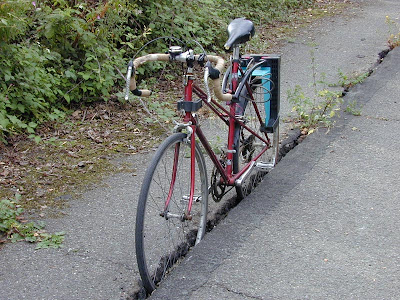Thanks to Andrea Wagnon for linking me up to this over on Facebook!
http://www.medicinenet.com/script/main/art.asp?articlekey=52408
Do mindless activity and bad habits have a hold on you? Get the tow truck, you're in a rut.
By Jeanie Lerche Davis
WebMD Feature
Published Feb. 18, 2004
Downtime is America's favorite pastime. We zone out via television, the Internet, shopping, parties, movies, hanging out, and working out. Sure, some are bad habits; some are "therapy." Most are escapes from a gerbil-wheel life.
That's when it hits you: Is this all there is?
For Judith Wright, author of Soft Addictions: There Must Be More Than This, this philosophical crisis occurred when life was a flurry of activity -- and as her first marriage was ending.
"Something was missing," writes Wright. The crux of the problem: Her life had become exceedingly superficial, because of what she calls 'soft addictions.'
"Soft addictions are those seemingly harmless habits like watching too much television, over-shopping, surfing the Internet, gossiping -- the things we overdo but we don't realize it," Wright tells WebMD. "It seems like normal behavior, but that's simply because everyone is doing it, too."
Soft addictions can be a problem, Wright says, because life is to be lived and not escaped from.
It's true, anything in excess can be problematic, says Nadine Kaslow, PhD, professor of psychology and behavioral sciences at Emory University in Atlanta. "You need to ask yourself, 'How excessive is it? How much does it interfere with my life?'"
Not that all mindless indulgences are bad habits, says Kaslow. There's a place in our lives for pointless conversations, all those Seinfeld reruns, and mocha- almond fudge. "We do these things to cope with stress in our lives," she tells WebMD.
"It's legitimate after you have a stressful day, you need to chill out some," says Kaslow. "But if that's all you do, and you do it every night, all weekend, that's another matter and it's not good for your mental health.
Wright agrees. "It's when they become habitual and we're just going through the motions that they become a problem," she says. "These bad habits keep us from living a greater life of meaning and satisfaction that we really deserve."
Superficial Just Doesn't Satisfy
Upwards of 90% of Americans admit they have soft addictions, one survey showed. "I actually think it's 100%," says Wright. "I have not met anyone who doesn't have them. No matter how well off or how educated they are, everyone has them."
In relationships -- whether you're married or otherwise -- you think you're relating to each other, but often you're just sharing soft addictions, Wright tells WebMD. "You think you had a great evening at home, but you weren't really connecting. That's why relationships don't go anywhere, why they burn out."
Friendships and social occasions can be stimulating and nurturing. But they can also be very superficial. "They can be mindless, gossipy, not-making-real-contact, nonnourishing events -- if there's no depth to conversations, if you're not genuine, if you're just saying expected lines, if you're talking about other people. You're not enriching your life."
She uses herself as an example: When she let go of one bad habit -- endlessly reading magazines and newspapers -- she substituted great literature, which was more rewarding. After that change, she found herself weeding out other soft addictions. She discovered that she related differently to people in her life.
"I began speaking more deeply from my heart about my feelings," Wright tells WebMD. "I took more walks in the park, listened to great music, meditated, started bringing in flowers. The other things [her soft addictions] weren't attractive to me any more."
"Soft addictions are webs, the fabric of your lifestyle," she explains. "When you're overworking, you're addicted to gourmet coffee, then you're all jittery, biting nails, stressful, calming down in front of the tube, then you're surfing the Internet, staying up too late, and you're tired the next day. But people don't always realize the connection."
Designing New Fabric
Breaking a bad habit or soft addiction isn't easy, Wright admits. Here are some suggestions:
* Start by identifying one bad habit. Maybe you head out shopping every Saturday morning. Next time, stop at a used bookstore on your way home, and find something worth reading. This way, "you've broken the routine, and added something more nourishing to your life," Wright says.
* Find other things that you enjoy. Add more things to your new routine. Soon, you'll be cutting back on shopping sprees -- but you won't feel deprived, she says. It's what she calls, "The Math of More." "You learn to add more nourishing things to your life, so you can subtract your soft addictions. Eventually, you come to enjoy these new things so much, they crowd out your soft addictions."
* Take time to write down a bigger vision for your life. This way your new choices have a context, so they make sense in terms of your priorities.
* Don't worry if breaking bad habits seem difficult. "It's not like it's a quick fix. It's not going to happen overnight," says Wright. "It's really about learning to live the journey of life. It's cumulative. You're discovering who you really are."
http://www.medicinenet.com/script/main/art.asp?articlekey=52408
Do mindless activity and bad habits have a hold on you? Get the tow truck, you're in a rut.
By Jeanie Lerche Davis
WebMD Feature
Published Feb. 18, 2004
Downtime is America's favorite pastime. We zone out via television, the Internet, shopping, parties, movies, hanging out, and working out. Sure, some are bad habits; some are "therapy." Most are escapes from a gerbil-wheel life.
That's when it hits you: Is this all there is?
For Judith Wright, author of Soft Addictions: There Must Be More Than This, this philosophical crisis occurred when life was a flurry of activity -- and as her first marriage was ending.
"Something was missing," writes Wright. The crux of the problem: Her life had become exceedingly superficial, because of what she calls 'soft addictions.'
"Soft addictions are those seemingly harmless habits like watching too much television, over-shopping, surfing the Internet, gossiping -- the things we overdo but we don't realize it," Wright tells WebMD. "It seems like normal behavior, but that's simply because everyone is doing it, too."
Soft addictions can be a problem, Wright says, because life is to be lived and not escaped from.
It's true, anything in excess can be problematic, says Nadine Kaslow, PhD, professor of psychology and behavioral sciences at Emory University in Atlanta. "You need to ask yourself, 'How excessive is it? How much does it interfere with my life?'"
Not that all mindless indulgences are bad habits, says Kaslow. There's a place in our lives for pointless conversations, all those Seinfeld reruns, and mocha- almond fudge. "We do these things to cope with stress in our lives," she tells WebMD.
"It's legitimate after you have a stressful day, you need to chill out some," says Kaslow. "But if that's all you do, and you do it every night, all weekend, that's another matter and it's not good for your mental health.
Wright agrees. "It's when they become habitual and we're just going through the motions that they become a problem," she says. "These bad habits keep us from living a greater life of meaning and satisfaction that we really deserve."
Superficial Just Doesn't Satisfy
Upwards of 90% of Americans admit they have soft addictions, one survey showed. "I actually think it's 100%," says Wright. "I have not met anyone who doesn't have them. No matter how well off or how educated they are, everyone has them."
In relationships -- whether you're married or otherwise -- you think you're relating to each other, but often you're just sharing soft addictions, Wright tells WebMD. "You think you had a great evening at home, but you weren't really connecting. That's why relationships don't go anywhere, why they burn out."
Friendships and social occasions can be stimulating and nurturing. But they can also be very superficial. "They can be mindless, gossipy, not-making-real-contact, nonnourishing events -- if there's no depth to conversations, if you're not genuine, if you're just saying expected lines, if you're talking about other people. You're not enriching your life."
She uses herself as an example: When she let go of one bad habit -- endlessly reading magazines and newspapers -- she substituted great literature, which was more rewarding. After that change, she found herself weeding out other soft addictions. She discovered that she related differently to people in her life.
"I began speaking more deeply from my heart about my feelings," Wright tells WebMD. "I took more walks in the park, listened to great music, meditated, started bringing in flowers. The other things [her soft addictions] weren't attractive to me any more."
"Soft addictions are webs, the fabric of your lifestyle," she explains. "When you're overworking, you're addicted to gourmet coffee, then you're all jittery, biting nails, stressful, calming down in front of the tube, then you're surfing the Internet, staying up too late, and you're tired the next day. But people don't always realize the connection."
Designing New Fabric
Breaking a bad habit or soft addiction isn't easy, Wright admits. Here are some suggestions:
* Start by identifying one bad habit. Maybe you head out shopping every Saturday morning. Next time, stop at a used bookstore on your way home, and find something worth reading. This way, "you've broken the routine, and added something more nourishing to your life," Wright says.
* Find other things that you enjoy. Add more things to your new routine. Soon, you'll be cutting back on shopping sprees -- but you won't feel deprived, she says. It's what she calls, "The Math of More." "You learn to add more nourishing things to your life, so you can subtract your soft addictions. Eventually, you come to enjoy these new things so much, they crowd out your soft addictions."
* Take time to write down a bigger vision for your life. This way your new choices have a context, so they make sense in terms of your priorities.
* Don't worry if breaking bad habits seem difficult. "It's not like it's a quick fix. It's not going to happen overnight," says Wright. "It's really about learning to live the journey of life. It's cumulative. You're discovering who you really are."



























